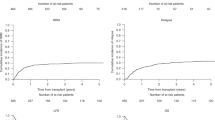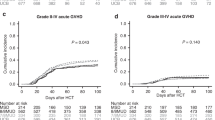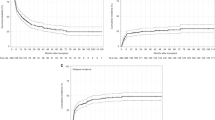Abstract
Many parameters predict for outcome after unrelated donor (URD) allogeneic hematopoietic stem cell transplantation (alloSCT). High-resolution HLA-matching significantly impacts outcome and also the European Group of Blood and Marrow Transplantation (EBMT) risk score, based on patient age, disease stage, donor type, time from diagnosis to SCT and gender combination, may predict for non-relapse mortality and overall survival (OS). We evaluated the individual and combined effects of allele-matching and the EBMT risk score in 327 patients with poor-risk acute leukemia or myelodysplasia, who received a T-cell depleted URD alloSCT. Matching for HLA-A, -B, -C and -DRB1 alleles (8/8 match) was associated with a 5-year OS of 40% compared with 30% for mismatched (⩽7/8) pairs (P=0.02). Patients with EBMT risk scores of 1–2, 3, 4 and 5–7 had 5-year OS estimates of 53, 43, 30 and 20%, respectively (P<0.001). The favorable prognostic impact of an 8/8 donor was most pronounced if the EBMT risk score was low (1–2). Five-year OS was 74±8% vs 39±11% for fully matched patients with a low-risk EBMT score as compared with EBMT low-risk patients with ⩽7/8 donors. These data underscore the importance of incorporating both the EBMT risk score and the degree of high-resolution HLA-matching in the risk assessment prior to URD alloSCT.
This is a preview of subscription content, access via your institution
Access options
Subscribe to this journal
Receive 12 print issues and online access
$259.00 per year
only $21.58 per issue
Buy this article
- Purchase on Springer Link
- Instant access to full article PDF
Prices may be subject to local taxes which are calculated during checkout


Similar content being viewed by others
References
Appelbaum FR . Incorporating hematopoietic cell transplantation (HCT) into the management of adults aged under 60 years with acute myeloid leukemia (AML). Best Pract Res Clin Haematol 2008; 21: 85–92.
Rowe JM . Graft-versus-disease effect following allogeneic transplantation for acute leukaemia. Best Pract Res Clin Haematol 2008; 21: 485–502.
Lodewyck T, Cornelissen JJ . Allogeneic stem cell transplantation in acute myeloid leukemia: a risk-adapted approach. Blood Rev 2008; 22: 293–302.
Rowe JM . Optimal management of adults with ALL. Br J Haematol 2009; 144: 468–483.
Yanada M, Matsuo K, Emi N, Naoe T . Efficacy of allogeneic hematopoietic stem cell transplantation depends on cytogenetic risk for acute myeloid leukemia in first disease remission: a metaanalysis. Cancer 2005; 103: 1652–1658.
Koreth J, Schlenk R, Kopecky KJ, Honda S, Sierra J, Djulbegovic BJ et al. Allogeneic stem cell transplantation for acute myeloid leukemia in first complete remission: systematic review and meta-analysis of prospective clinical trials. JAMA 2009; 301: 2349–2361.
Cornelissen JJ, van Putten WLJ, Verdonck LF, Theobald M, Jacky E, Daenen SM et al. Results of a HOVON/SAKK donor versus no-donor analysis of myeloablative HLA-identical sibling stem cell transplantation in first remission acute myeloid leukemia in young and middle-aged adults: benefits for whom? Blood 2007; 109: 3658–3666.
Goldstone AH, Richards SM, Lazarus HM, Tallman MS, Buck G, Fielding AK et al. In adults with standard-risk acute lymphoblastic leukemia, the greatest benefit is achieved from a matched sibling allogeneic transplantation in first complete remission, and an autologous transplantation is less effective than conventional consolidation/maintenance chemotherapy in all patients: final results of the International ALL Trial (MRC UKALL XII/ECOG E2993). Blood 2008; 111: 1827–1833.
Hahn T, Wall D, Camitta B, Davies S, Dillon H, Gaynon P et al. The role of cytotoxic therapy with hematopoietic stem cell transplantation in the therapy of acute lymphoblastic leukemia in adults: an evidence-based review. Biol Blood Marrow Transplant 2006; 12: 1–30.
Appelbaum FR . Hematopoietic cell transplantation from unrelated donors for treatment of patients with acute myeloid leukemia in first complete remission. Best Pract Res Clin Haematol 2007; 20: 67–75.
Krauter J, Heil G, Hoelzer D, Ottmann O, Martin H, Lübbert M et al. Role of consolidation therapy in the treatment of patients up to 60 years with high risk AML. Blood 2005; 106: abstract 172.
Yakoub-Agha I, Mesnil F, Kuentz M, Boiron JM, Ifrah N, Milpied N et al. Allogeneic marrow stem-cell transplantation from human leukocyte antigen-identical siblings versus human leukocyte antigen-allelic-matched unrelated donors (10/10) in patients with standard-risk hematologic malignancy: a prospective study from the French Society of Bone Marrow Transplantation and Cell Therapy. J Clin Oncol 2006; 24: 5695–5702.
Schetelig J, Bornhäuser M, Schmid Ch, Hertenstein B, Schwerdtfeger R, Martin H et al. Matched unrelated or matched sibling donors result in comparable survival after allogeneic stem-cell transplantation in elderly patients with acute myeloid leukemia: a report from the cooperative german transplant study group. J Clin Oncol 2008; 26: 5183–5191.
Basara N, Schulze A, Wedding U, Mohren M, Gerhardt A, Junghanss C et al. Early related or unrelated haematopoietic cell transplantation results in higher overall survival and leukaemia-free survival compared with conventional chemotherapy in high-risk acute myeloid leukaemia patients in first complete remission. Leukemia 2009; 23: 635–640.
Gupta V, Tallman MS, He W, Logan BR, Copelan E, Gale RP et al. Comparable survival after HLA-well-matched unrelated or matched sibling donor transplantation for acute myeloid leukemia in first remission with unfavorable cytogenetics at diagnosis. Blood 2010; 116: 1839–1848.
Federmann B, Faul Ch, Vogel W, Kanz L, Bethge WA . Allogeneic hematopoietic cell transplantation in AML: Comparable results after matched or mismatched unrelated versus matched related transplantation. Blood 2009; 114: abstract 1199.
Walter RB, Pagel JM, Gooley TA, Petersdorf EW, Sorror ML, Woolfrey AE et al. Comparison of matched unrelated and matched related donor myeloablative hematopoietic cell transplantation for adults with acute myeloid leukemia in first remission. Leukemia 2010; 24: 1276–1282.
Gratwohl A, Hermans J, Goldman JM, Arcese W, Carreras E, Devergie A et al. Risk assessment for patients with chronic myeloid leukaemia before allogeneic blood or marrow transplantation. Lancet 1998; 352: 1087–1092.
Gratwohl A, Stern M, Brand R, Apperley J, Baldomero H, de Witte T et al. Risk score for outcome after allogeneic hematopoietic stem cell transplantation: a Retrospective Analysis. Cancer 2009; 115: 4715–4726.
Sorror ML, Maris MB, Storb R, Storer BE, Stuart MJ, Hegenbart U et al. Hematopoietic cell transplantation (HCT)-specific comorbidity index: a new tool for risk assessment before allogeneic HCT. Blood 2005; 106: 2912–2919.
Sorror ML, Giralt S, Sandmaier BM, De Lima M, Shahjahan M, Maloney DG et al. Hematopoietic cell transplantation specific comorbidity index as an outcome predictor for patients with acute myeloid leukemia in first remission: combined FHCRC and MDACC experiences. Blood 2007; 110: 4606–4613.
Majhail NS, Brunstein CG, McAvoy S, DeFor TE, Al-Hazzouri A, Setubal D et al. Does the hematopoietic cell transplantation specific comorbidity index predict transplant outcomes? A validation study in a large cohort of umbilical cord blood and matched related donor transplants. Biol Blood Marrow Transplant 2008; 14: 985–992.
Farina L, Bruno B, Patriarca F, Spina F, Sorasio R, Morelli M et al. The hematopoietic cell transplantation comorbidity index (HCT-CI) predicts clinical outcomes in lymphoma and myeloma patients after reduced-intensity or non-myeloablative allogeneic stem cell transplantation. Leukemia 2009; 23: 1131–1138.
Heemskerk M, van Walraven S, Cornelissen JJ, Barge R, Bredius R, Egeler R et al. How to improve the search for an unrelated haematopoietic stem cell donor. Faster is better than more! Bone Marrow Transplant 2005; 35: 645–652.
Przepiorka D, Weisdorf D, Martin P, Klingemann HG, Beatty P, Hows J et al. 1994 consensus conference on acute GVHD grading. Bone Marrow Transplant 1995; 15: 825–828.
Shulman HM, Sullivan KM, Weiden PL, McDonald GB, Striker GE, Sale GE et al. Chronic graft-versus-host syndrome in man. A long-term clinicopathologic study of 20 Seattle patients. Am J Med 1980; 69: 204–217.
Clift R, Goldman J, Gratwohl A, Horowitz M . Proposals for standardized reporting of results of bone marrow transplantation for leukaemia. Bone Marrow Transplant 1989; 4: 445–448.
Copelan E, Casper JT, Carter SL, van Burik JA, Hurd D, Mendizabal AM et al. A Scheme for Defining Cause of Death and Its Application in the T Cell Depletion Trial. Biol Blood Marrow Transplant 2007; 13: 1469–1476.
Shaw BE, Arguello R, Garcia-Sepulveda CA, Madrigal JA . The impact of HLA genotyping on survival following unrelated donor haematopoietic stem cell transplantation. Br J Haematol 2010; 150: 251–258.
Kröger N, Zabelina T, Binder T, Ayuk F, Bacher U, Amtsfeld G et al. HLA-mismatched unrelated donors as an alternative graft source for allogeneic stem cell transplantation after antithymocyte globulin-containing conditioning regimen. Biol Blood Marrow Transplant 2009; 15: 454–462.
Crocchiolo R, Ciceri F, Fleischhauer K, Oneto R, Bruno B, Pollichieni S et al. HLA matching affects clinical outcome of adult patients undergoing haematopoietic SCT from unrelated donors: a study from the Gruppo Italiano Trapianto di Midollo Osseo and Italian Bone Marrow Donor Registry. Bone Marrow Transplant 2009; 44: 571–577.
Shaw BE, Mayor NP, Russell NH, Apperley JF, Clark RE, Cornish J et al. Diverging effects of HLA-DPB1 matching status on outcome following unrelated donor transplantation depending on disease stage and the degree of matching for other HLA alleles. Leukemia 2010; 24: 58–65.
Lee SJ, Klein J, Haagenson M, Baxter-Lowe LA, Confer DL, Eapen M et al. High-resolution donor-recipient HLA matching contributes to the success of unrelated donor marrow transplantation. Blood 2007; 110: 4576–4583.
Petersdorf EW, Anasetti C, Martin PJ, Gooley T, Radich J, Malkki M et al. Limits of HLA mismatching in unrelated hematopoietic cell transplantation. Blood 2004; 104: 2976–2980.
Woolfrey AE, Klein J, Haagenson MD, Spellman SR, Battiwalla M, Gajewski JL et al. Evaluation of Human Leukocyte Antigen (HLA) Matching Requirements for Unrelated Peripheral Blood Stem Cell (PBSC) Transplantation. Blood 2008; 112: abstract 563.
Morishima Y, Sasazuki T, Inoko H, Juji T, Akaza T, Yamamoto K et al. The clinical significance of human leukocyte antigen (HLA) allele compatibility in patients receiving a marrow transplant from serologically HLA-A, HLA-B, and HLA-DR matched unrelated donors. Blood 2002; 99: 4200–4206.
Flomenberg N, Baxter-Lowe LA, Confer D, Fernandez-Vina M, Filipovich A, Horowitz M et al. Impact of HLA class I and class II high-resolution matching on outcomes of unrelated donor bone marrow transplantation: HLA-C mismatching is associated with a strong adverse effect on transplantation outcome. Blood 2004; 104: 1923–1930.
Petersdorf EW, Gooley TA, Anasetti C, Martin PJ, Smith AG, Mickelson EM et al. Optimizing outcome after unrelated marrow transplantation by comprehensive matching of HLA class I and II alleles in the donor and recipient. Blood 1998; 92: 3515–3520.
Sasazuki T, Juji T, Morishima Y, Kinukawa N, Kashiwabara H, Inoko H et al. Effect of matching of class I HLA alleles on clinical outcome after transplantation of hematopoietic stem cells from an unrelated donor. Japan Marrow Donor Program. N Engl J Med 1998; 339: 1177–1185.
Petersdorf EW, Kollman C, Hurley CK, Dupont B, Nademanee A, Begovich AB et al. Effect of HLA class II gene disparity on clinical outcome in unrelated donor hematopoietic cell transplantation for chronic myeloid leukemia: the US National Marrow Donor Program Experience. Blood 2001; 98: 2922–2929.
Greinix HT, Faé I, Schneider B, Rosenmayr A, Mitterschiffthaler A, Pelzmann B et al. Impact of HLA class I high-resolution mismatches on chronic graft-versus-host disease and survival of patients given hematopoietic stem cell grafts from unrelated donors. Bone Marrow Transplant 2005; 35: 57–62.
Ho VT, Kim HT, Liney D, Milford E, Gribben J, Cutler C et al. HLA-C mismatch is associated with inferior survival after unrelated donor non-myeloablative hematopoietic stem cell transplantation. Bone Marrow Transplant 2006; 37: 845–850.
Meijer E, Cornelissen JJ . Allogeneic stem cell transplantation in acute myeloid leukemia in first or subsequent remission: weighing prognostic markers predicting relapse and risk factors for non-relapse mortality. Semin Oncol 2008; 35: 449–457.
Author information
Authors and Affiliations
Corresponding author
Ethics declarations
Competing interests
The authors declare no conflict of interest.
Additional information
Supplementary Information accompanies the paper on the Leukemia website
Supplementary information
Rights and permissions
About this article
Cite this article
Lodewyck, T., Oudshoorn, M., van der Holt, B. et al. Predictive impact of allele-matching and EBMT risk score for outcome after T-cell depleted unrelated donor transplantation in poor-risk acute leukemia and myelodysplasia. Leukemia 25, 1548–1554 (2011). https://doi.org/10.1038/leu.2011.123
Received:
Revised:
Accepted:
Published:
Issue Date:
DOI: https://doi.org/10.1038/leu.2011.123
Keywords
This article is cited by
-
Up-to-date tools for risk assessment before allogeneic hematopoietic cell transplantation
Bone Marrow Transplantation (2016)
-
Clinical comorbidity predictive measures in ex vivo T-cell-depleted allogeneic hematopoietic stem cell transplantation
Bone Marrow Transplantation (2015)
-
Application of machine learning algorithms for clinical predictive modeling: a data-mining approach in SCT
Bone Marrow Transplantation (2014)
-
EBMT risk score can predict the outcome of leukaemia after unmanipulated haploidentical blood and marrow transplantation
Bone Marrow Transplantation (2014)
-
The European LeukemiaNet AML Working Party consensus statement on allogeneic HSCT for patients with AML in remission: an integrated-risk adapted approach
Nature Reviews Clinical Oncology (2012)



